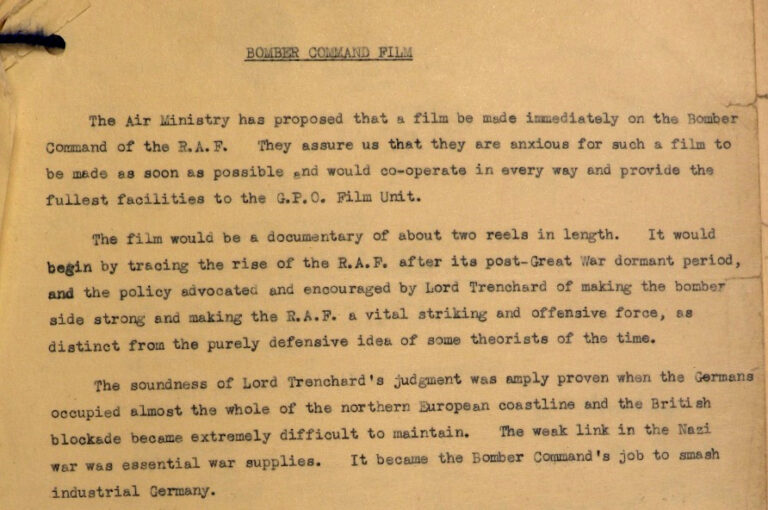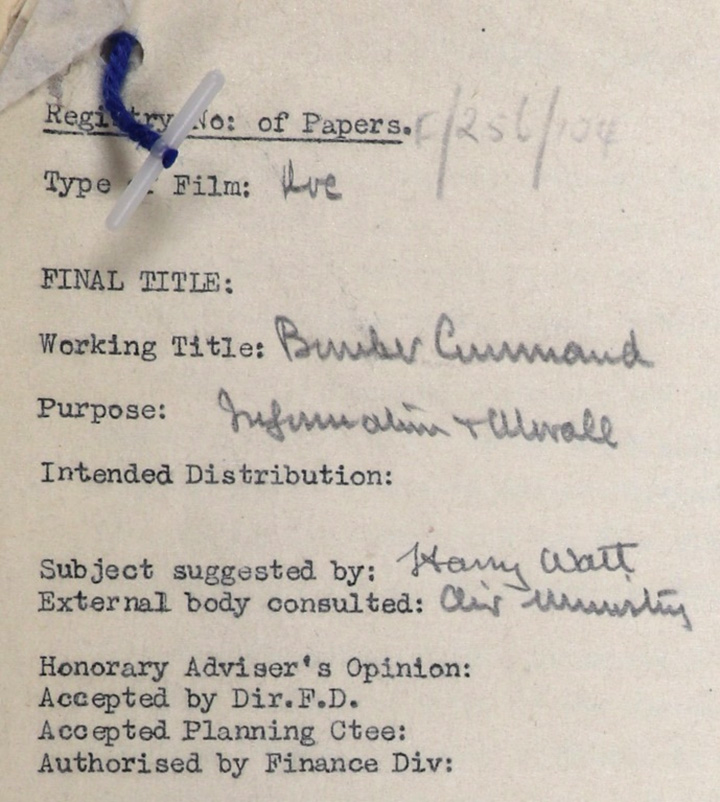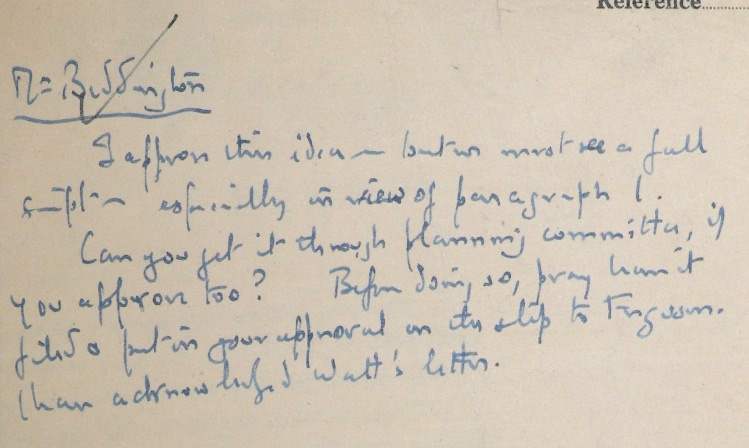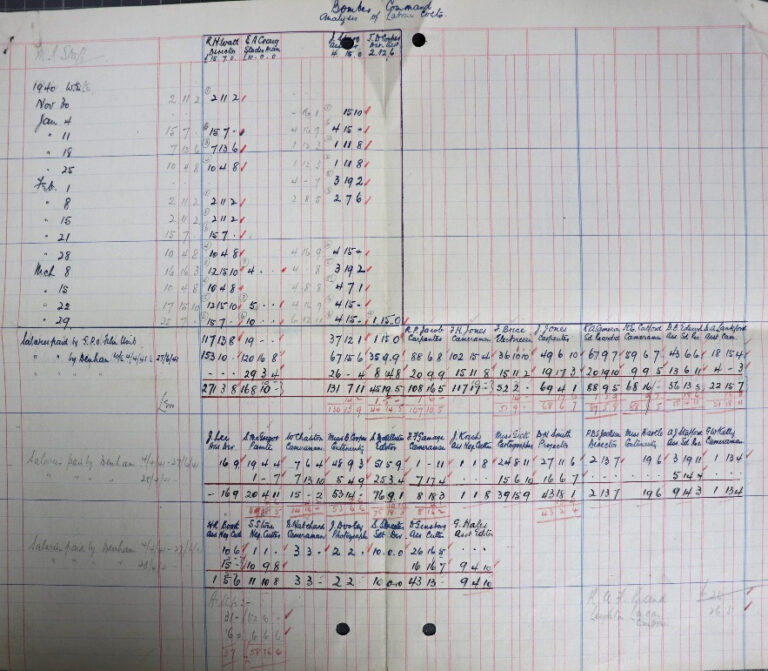Eighty years ago, on 25 July 1941, the Ministry of Information released a film that marked a new direction in wartime propaganda. The film was ‘Target for Tonight’, made by the Crown Film Unit, produced by Ian Dalrymple and directed by Harry Watt.
The National Archives has an interesting and largely under-explored collection of records relating to films produced by government from the early 20th century to the start of the 21st. Many of them were short informational films, but others, like ‘Target for Tonight’, were full feature-length films, released in cinemas, that even turned a profit.
In his book, The British at War: Cinema, State and Propaganda 1939-1945 1, James Chapman explains that before ‘Target for Tonight’, government propaganda films, such as ‘London Can Take It’, had focused on the stoicism of the British public – putting up with whatever Hitler could throw at them and carrying on regardless. What made ‘Target for Tonight’ different, and indeed popular, was that it showed Britain fighting back and attacking a German target in a night-time bombing raid. It also used real, serving members of the forces rather than actors.
A Ministry of Information correspondence file, INF 1/210, shows the development of the idea for a film about RAF Bomber Command which eventually became ‘Target for Tonight’. Following the Battle of Britain from July to October 1940, the British public were well aware of the RAF’s defensive role, but the Ministry of Information file demonstrates that ‘Target for Tonight’ was intended to emphasise the RAF’s attacking role:
‘The film would be a documentary of about two reels in length. It would begin by tracing the rise of the RAF after its post-Great War dormant period and the policy advocated and encouraged by Lord Trenchard of making the bomber side strong and making the RAF a vital striking and offensive force, as distinct from the purely defensive idea of some theorists of the time.’

Another paper from the same file lists the film’s purpose as ‘Information and Morale’:

The plot of the film follows RAF Bomber Command as they plan and carry out a raid on an oil depot in woods near Freihausen in Germany. The film focuses on the crew of a Wellington Bomber with the call sign ‘F for Freddie’, as it makes the journey from Millerton Aerodrome to Germany. The Wellington crew navigates by following the path of a canal to find the target and eventually drop its bombs.
German ground defences fire back and the Wellington’s wireless set is damaged and its operator wounded, leaving the crew out of contact with their base. The oil pressure in the port engine drops and the aircraft struggles to gain height. As the other crews arrive safely back at Millerton, F for Freddie fails to appear, and with no radio communication and worsening weather conditions, there’s an anxious wait to see if they return. Eventually they do make it back and there’s a rather understated sense of relief all round.

The film was shot on location in RAF Mildenhall (Millerton Aerodrome in the film) and the RAF Bomber Command Operations Room was recreated at Denham film studios. All the characters in the film were played by serving military personnel, and the Commander-in-Chief of Bomber Command, Air Chief Marshall Sir Richard Peirse, played himself 2.
The pilot of the Wellington, Squadron Leader Dickson, was played by Group Captain Percy Charles Pickard, DSO and Two Bars, DFC 3. He was killed a few years later, aged 28, during a raid on Amiens on 18 February 1944 4. Although the service records of people in the forces during the Second World War are not yet open to the public, there are other online sources you can use to find out more about them. For example, in the case of Percy Pickard you can see Commonwealth War Graves 5 and London Gazette 6 entries for him as well as a portrait of him at the Imperial War Museum 7.
The correspondence file INF 1/210 includes a film treatment (an outline of the story and characters), a script and shot lists (describing the shots required for each scene).

It also includes correspondence between the people working in the Crown Film Unit about costs. By April 1941 the budget had increased from £3,000 to £5,126 and in May there was some consternation about an unexpected bill of nearly £90 from the Strand Hotel in London, where some of the Bomber crew used in the film had stayed (some with their wives) during the shooting. Mr Mercier of the Ministry of Information was not pleased to receive the bill without prior agreement, and wrote to Miss Dora Wright at the Crown Film Unit in Denham on 13 May 1941 to say:
‘You may take it quite definitely that such accounts will not be passed unless the circumstances are very exceptional. Finance will not agree to give authority for the expenses of wives or for unlimited expenses.’
But the producer, Ian Dalrymple, was frustrated by the criticism he received from Mr Mercier, saying in reply two days later:
‘It would be of inestimable value to me if officials of HM Treasury would kindly visit us for a period and give us a demonstration of how we are to obtain desirable results with absolutely no discretion in the “nursing” of our “actors”. If I am to be forbidden this discretion, then (having already surrendered five-sixths of my income) I suppose I shall have to pay for these additional items myself out of what I have been reduced to in a desire to serve the state.’
The poet and writer John Betjeman was working as a script reader in the Ministry of Information Films Division during the war 8, and the file INF 1/210 includes correspondence from him. In a note to Jack Beddington, the Director of the Films Division, in November 1940, Betjeman says of the initial proposal to make a film about Bomber Command:
‘I approve this idea – but we must see a full script – especially in view of paragraph 1. Can you get it through planning committee, if you approve too? Before doing so, pray have it filed and put in your approval on its step to Ferguson. I have acknowledged Watt’s letter.’

The correspondence file also contains rather curious mentions of two film stars of the day: Marlene Dietrich and George Formby. A note to Sidney Bernstein at the Ministry of Information from Paul Holt at the Daily Express says:

‘Thank you very much for offering copies of “Target for Tonight” and two Russian newsreels to Lord Beaverbrook. It will make a big difference after Marlene Dietrich.’
The only hint of an explanation I could find online was that the song ‘Boys in the Backroom’ sung by Dietrich in the film ‘Destry Rides Again’ (1939), was quoted in a speech by Lord Beaverbrook in March 1941 who was, apparently enamoured of her 9.
Another letter this time from Mr Griggs to Sidney Bernstein written almost a week after the premiere on 25 July 1941, alludes to some problems with seat allocations at the event and says at the end:
‘The incident in which George Formby was concerned was unfortunate and caused by an excess of zeal on the part of either Williams of ABFD, Forsyth, or a cameraman on the lookout for a news photo.’
There are two other files at The National Archives that relate to ‘Target for Tonight’. The production file INF 6/335 contains a script, music cue sheet and details of shots and sequences for each film reel; and INF 5/81 includes accounts and forms relating to the application to have the film registered as ‘British made’.

As James Chapman explains in his book, ‘Target for Tonight’ was the first in a series of three feature-length propaganda films made by the Ministry of Information. The second was ‘Coastal Command’ (1942) which explores the role of the RAF in escorting maritime convoys, defending them from attacks by U-boats and German warships. The third film was ‘Western Approaches’ (1944) which featured another maritime convoy, along with a group of shipwrecked merchant seamen awaiting rescue from their lifeboat.
All three films can be found online and give a really interesting insight into what it was like to be a crew member on a bombing raid or escorting a convoy, as well as a stark portrayal of the diminishing hopes of men trapped in a small lifeboat in the middle of a huge ocean. I really recommend watching all three films whether your interest is in film history, government propaganda or family history. ‘Target for Tonight’ is being released on Blu-ray by the BFI – find out more here.
To find out more about the records we have relating to government and film, see our research guide Government film-making and the film industry.
To find out more about RAF records from the Second World War see the various research guides on the Second World War RAF and other air services category on the Help with your Research pages of our website.
Notes:
- The British at War: Cinema, State and Propaganda 1939-1945 by James Chapman, published by I B Tauris, 1998. ↩
- ibid. ↩
- https://en.wikipedia.org/wiki/Target_for_Tonight accessed 22 July 2021. ↩
- https://en.wikipedia.org/wiki/Percy_Charles_Pickard accessed 22 July 2021. ↩
- https://www.cwgc.org/find-records/find-war-dead/casualty-details/2847235/PERCY%20CHARLES%20PICKARD/ accessed 21 July 2021. ↩
- http://www.rafcommands.com/database/wardead/details.php?qnum=35925 accessed 21 July 2021. ↩
- https://www.iwm.org.uk/collections/item/object/26219 accessed 21 July 2021. ↩
- The British at War: Cinema, State and Propaganda 1939-1945 by James Chapman, published by I B Tauris 1998. ↩
- https://www.songfacts.com/facts/marlene-dietrich/see-what-the-boys-in-the-back-room-will-have accessed 22 July 2021. ↩

Glad to see this (very) occasional series is back and with a very well-researched piece.
More please!
Thanks Richard – glad you enjoyed the blog. We’re hoping to do more in this series so keep watching!